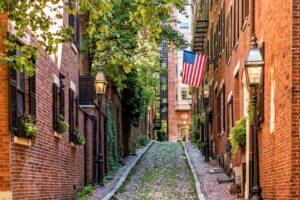Fodor's Expert Review Trinity Church
In his 1877 masterpiece, architect Henry Hobson Richardson brought his Romanesque Revival style to maturity; all the aesthetic elements for which he was famous come together magnificently—bold polychromatic masonry, careful arrangement of masses, sumptuously carved interior woodwork—in this crowning centerpiece of Copley Square. A full appreciation of its architecture requires an understanding of the logistical problems of building it here. The Back Bay is a reclaimed wetland with a high water table. Bedrock, or at least stable glacial till, lies far beneath wet clay. Like all older Back Bay buildings, Trinity Church sits on submerged wooden pilings. But its central tower weighs 9,500 tons, and most of the 4,500 pilings beneath the building are under that tremendous central mass. The pilings are checked regularly for sinkage by means of a hatch in the basement.
Richardson engaged some of the best artists of his day—John La Farge, William Morris, and Edward Burne-Jones among... READ MORE
In his 1877 masterpiece, architect Henry Hobson Richardson brought his Romanesque Revival style to maturity; all the aesthetic elements for which he was famous come together magnificently—bold polychromatic masonry, careful arrangement of masses, sumptuously carved interior woodwork—in this crowning centerpiece of Copley Square. A full appreciation of its architecture requires an understanding of the logistical problems of building it here. The Back Bay is a reclaimed wetland with a high water table. Bedrock, or at least stable glacial till, lies far beneath wet clay. Like all older Back Bay buildings, Trinity Church sits on submerged wooden pilings. But its central tower weighs 9,500 tons, and most of the 4,500 pilings beneath the building are under that tremendous central mass. The pilings are checked regularly for sinkage by means of a hatch in the basement.
Richardson engaged some of the best artists of his day—John La Farge, William Morris, and Edward Burne-Jones among them—to execute the paintings and stained glass that make this a monument to everything that was right about the pre-Raphaelite spirit and the nascent aesthetic of Morris's Arts and Crafts movement. Along the north side of the church, note the Augustus Saint-Gaudens statue of Phillips Brooks—the most charismatic rector in New England, who almost single-handedly got Trinity built and furnished. The shining light of Harvard's religious community and lyricist of "O Little Town of Bethlehem," Brooks is shown here with Christ touching his shoulder in approval. For a nice respite, try to catch one of the Friday organ concerts beginning at 12:15. Free drop-in guided tours are held throughout the week.
READ LESS






